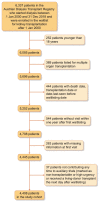Sex differences in the survival benefit of kidney transplantation: a retrospective cohort study using target trial emulation
- PMID: 37403325
- PMCID: PMC10730810
- DOI: 10.1093/ndt/gfad137
Sex differences in the survival benefit of kidney transplantation: a retrospective cohort study using target trial emulation
Abstract
Background: Kidney transplantation is the preferred treatment for eligible patients with kidney failure who need renal replacement therapy. However, it remains unclear whether the anticipated survival benefit from kidney transplantation is different for women and men.
Methods: We included all dialysis patients recorded in the Austrian Dialysis and Transplant Registry who were waitlisted for their first kidney transplant between 2000 and 2018. In order to estimate the causal effect of kidney transplantation on 10-year restricted mean survival time, we mimicked a series of controlled clinical trials and applied inverse probability of treatment and censoring weighted sequential Cox models.
Results: This study included 4408 patients (33% female) with a mean age of 52 years. Glomerulonephritis was the most common primary renal disease both in women (27%) and men (28%). Kidney transplantation led to a gain of 2.22 years (95% CI 1.88 to 2.49) compared with dialysis over a 10-year follow-up. The effect was smaller in women (1.95 years, 95% CI 1.38 to 2.41) than in men (2.35 years, 95% CI 1.92 to 2.70) due to a better survival on dialysis. Across ages the survival benefit of transplantation over a follow-up of 10 years was smaller in younger women and men and increased with age, showing a peak for both women and men aged about 60 years.
Conclusions: There were few differences in survival benefit by transplantation between females and males. Females had better survival than males on the waitlist receiving dialysis and similar survival to males after transplantation.
Keywords: kidney transplantation; renal dialysis; retrospective study; sex; survival.
© The Author(s) 2023. Published by Oxford University Press on behalf of the ERA.
Conflict of interest statement
None declared.
Figures




References
-
- Jensen CE, Sørensen P, Petersen KD. In Denmark kidney transplantation is more cost-effective than dialysis. Dan Med J 2014;61:A4796. - PubMed
Publication types
MeSH terms
Grants and funding
LinkOut - more resources
Full Text Sources
Medical

